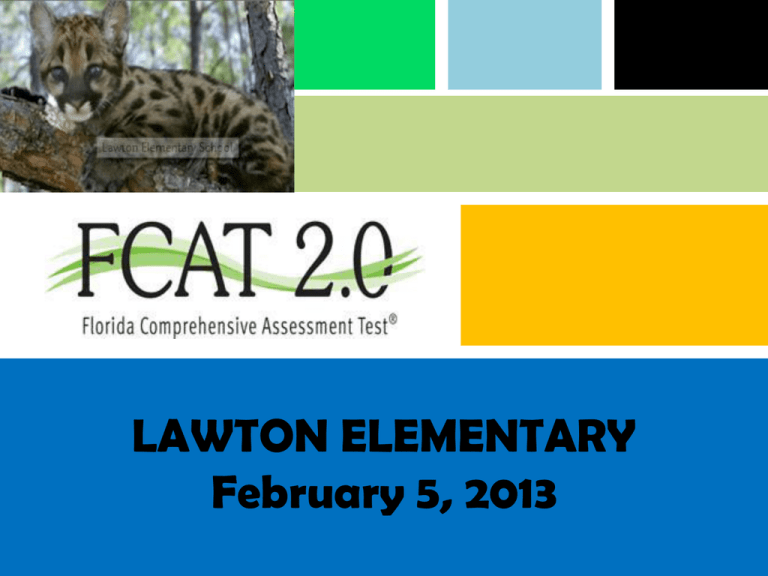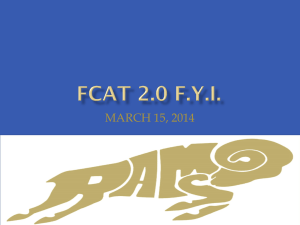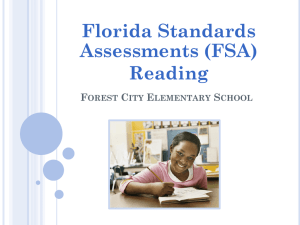How are FCAT 2.0 Results Used?
advertisement

LAWTON ELEMENTARY February 5, 2013 Agenda • What’s New and Reminders? • What is FCAT/FCAT 2.0? – – – – Who takes the test? When is the test? Is the test timed? How is the test designed? • Testing Tips • How is the FCAT/FCAT 2.0 used? – Grade 3 – Levels 1 and 2 scores in Reading and Mathematics – School Grades and Annual Measurable Objectives • Helpful Resources Changes to FCAT… Please help me pass the FCAT – I mean FCAT 2.0… Please don’t ever make an FDOG… NEW…Computer-based Test • Grade 5 Math will be a computer-based test beginning this spring – Students will be required to participate in a practice test session prior to the actual test • Practice using testing platform and tools, answering questions, changing answers, submitting test, etc. – Accommodated versions are available for students with visual exceptionalities • Large print, zoom, color contrast, screen reader, or combination – Students will receive work folder to use for working problems ePAT – CBT Practice Test • Parents may practice the Grade 5 Math computer-based practice test at home with their student – Go to www.FLAssessments.com/ePATs 1. 2. 3. Click and review How to Install ePATs Click Install Launcher Click on either Grade 5 Math Practice Test-Mac OR Grade 5 Math Practice Test-Windows • Remember the practice test is ONLY used for students to become familiar with the tools and navigation on the computer-based test and does not reflect the types of questions that will be on the FCAT 2.0 Math test. NEW…Test Rules Acknowledgment • Test Rules Acknowledgment – Students will be required to sign (paper tests) or agree to (computer test) the Test Rules Acknowledgment before taking any FCAT 2.0 assessment. • Test Rules Acknowledgment reads: “I understand the testing rules that were just read to me. If I do not follow these rules, my test score will be invalidated.” Electronic Devices Reminder • No electronic devices permitted during testing – Students CANNOT have any electronic device (e.g., cell phone, mp3 player, game system, etc.) on them OR within arm’s reach even if they do not use them – Cause for immediate invalidation of test What is FCAT 2.0? • Florida Comprehensive Assessment Test® 2.0 – Measures student success with the Next Generation Sunshine State Standards (NGSSS) • More information about NGSSS go to www.floridastandards.org – Example of a Benchmark General Information Benchmark Number: LA.3.1.7.3 Benchmark Description: The student will determine explicit ideas and information in grade-level text, including but not limited to main idea, relevant supporting details, strongly implied message and inference, and chronological order of events; Subject Area: Reading/Language Arts Grade Level: 3 Strand: Reading Process Standard: Reading Comprehension - The student uses a variety of strategies to comprehend grade level text. Date Adopted or Revised: 01/07 Status: State Board Approved Who takes the FCAT/FCAT 2.0 in Elementary School? • FCAT 2.0 Reading – Grades 3, 4, and 5 • FCAT 2.0 Mathematics – Grades 3, 4, and 5 • FCAT Writing – Grade 4 • FCAT 2.0 Science – Grade 5 When is the FCAT/FCAT 2.0? • FCAT Writing – Grade 4 – Tuesday, February 26, 2013 – Make-up day Wednesday, February 27th • FCAT 2.0 Reading, Mathematics, and Science – Grade 3 and 4 Reading and Math: April 15 – April 19, 2013 – Grade 5 Reading and Science: April 15 – April 19, 2013 – Grade 5 Math (computer-based): April 22 - 26, 2013 Is the test timed? YES • Reading and Mathematics Grades 3, 4, and 5 • 140 minutes (two 70 minute sessions) • Tested over two days • Science – Grade 5 • 160 minutes (two 80 minute sessions) • Tested over two days • Writing – Grade 4 • 60 minutes (previous years it was 45 minutes) How is the FCAT/FCAT 2.0 designed? Content Categories and approximate percentage of raw-score points for each category • FCAT 2.0 Reading • Grade Vocabulary Reading Application Literary Analysis: Fiction & Nonfiction Informational & Research Process 3-5 50-55 Multiple Choice 15-25% 25-35% 25-35% 15-25% FCAT 2.0 Mathematics Grade 3 50-55 Multiple Choice 4 35-40 Multiple Choice 10-15 Gridded Response 5 35-40 Multiple Choice 10-15 Gridded Response Category Percentage Number: Operations, Problems, and Statistics 50 Number: Fractions 20 Geometry and Measurement 30 Number: Operations and Problems 45 Number: Base Ten and Fractions 25 Geometry and Measurement 30 Number: Base Ten and Fractions 50 Expressions, Equations, and Statistics 20 Geometry and Measurement 30 How is the FCAT/FCAT 2.0 designed? Content Categories and approximate percentage of raw-score points for each category • FCAT 2.0 Science Grade Nature of Science Earth and Space Science Physical Science Life Science 5 60-66 Multiple Choice 17% 29% 29% 25% One prompt - students are expected to draft a response according to a specific purpose • FCAT Writing • Scale of 1.0 – 6.0 • Score of 4.0 is considered on grade-level Grade Narrative Expository 4 Writing to tell a story Writing to explain, interpret, or describe Testing Tips • Multiple-Choice Questions – Read the question, then skim the passage for hints – Make an educated decision of the remaining answers • Narrow your choices, eliminate answers you know are not correct • When eliminating answer choices, do not mark in answer bubbles Testing Tips • Gridded-Response Questions (Grades 4 and 5) – Make sure you transfer your answer correctly! – Left or right justify your answer, don’t leave it in the middle! • Mathematics Reference Sheet (Grade 5) – http://fcat.fldoe.org/fcat2/pdf/mg5rsr.pdf – Become familiar with the formulas on the reference sheet Helping Your Child • Reading – Read with your child and have them read to you • Use a variety of reading materials – Ask your child questions about what they read – Trips to the library • Mathematics – Go over mathematics homework with your child – Engage your child in real world activities • For example: buying food at the grocery store Helping Your Child • Writing – Have your child keep a journal of what they did at school/home for the week – Write letters to friends and relatives – Ask your child to write a story or to write about a topic they enjoy • Practice using a variety of sentence structures and topics • Science – Watch science programs on television – Visit local libraries and science centers • Have your child read about science topics they find interesting • Do small experiments at home Helping Your Child • Test Preparation – Help your child to realize that it is important to do their best every day, as well as on the FCAT 2.0 – Help your child practice the skills they are learning in reallife situations so that the skills have meaning beyond the FCAT 2.0 test – Help your child get a good night’s sleep and eat a nutritious breakfast – Overemphasizing the FCAT 2.0 can increase your child’s anxiety • Work with your child to help them learn how to handle anxiety How are FCAT 2.0 Results Used? • FCAT 2.0 results provide teachers and schools with additional information about each student’s proficiencies • Results are used IN ADDITION TO teacher observations and coursework throughout the year in making determinations of student strengths and areas of opportunity How are FCAT 2.0 Results Used? • Grade 3 Reading Scores – Students who score a Level 1 on Reading are required (by state law) to have further evaluation before being promoted to 4th grade • Options for Students who Score at Level 1 – ‘Good Cause’ Promotion Options • SAT 10 test • Portfolio of 3rd grade work demonstrating proficiency – Decisions are made on an individual-student basis How are FCAT 2.0 Results Used? • Students who score at Levels 1 or 2 on the Reading and/or Mathematics tests are required (by state law) to have intensive remedial assistance classes during the following school year – This intensive remediation must be different from previously received instruction – Students in this category are progress-monitored to ensure their success Florida’s A+ Program • The Florida Department of Education uses FCAT/FCAT 2.0 results to evaluate each public school and each school district • Grades are determined through performance on the FCAT 2.0 Reading, Mathematics, Writing, and Science tests • Learning Gains, growth from one year to the next for each student, are also taken into account – Special emphasis is placed on the lowest 25% of students from the previous year • Grades are determined through a cumulative-points system Florida’s A+ Program POINT SYSTEM • Earn one point for each percent of students scoring at Achievement Level 3 or higher on Reading, Mathematics and Science tests • Earn one point for each percent of students scoring a 3.5 or higher on the Writing Essay • Earn one point for each percent of students making Learning Gains in Reading and in Mathematics • Show Adequate Progress has been achieved in Reading and Mathematics for lowest 25% of students based on previous year’s scores – At least 50% must make gains in both Reading & Mathematics Florida’s A+ Program • 2012 Points Scale – – – – – A: 525 points or higher B: 495 - 524 points C: 435 - 494 points D: 395 - 434 points F: Fewer than 395 points • At least 90% of eligible students tested – 95% for a grade of “A” Lawton’s Grade in 2012 High Standards Reading (Level 3 & Above): Mathematics (Level 3 & Above): Science (Level 3 & Above): Writing (3.0 & Above): 84% 85% 84% 91% School Grade Learning Gains Reading: Mathematics: Lowest 25% Reading: Lowest 25% Mathematics: Total A+ Points: 77% 76% 76% 56% 629 A Annual Measurable Objectives • Each school and district must meet Annual Measurable Objectives in compliance with the ESEA Waiver requirements in lieu of meeting the No Child Left Behind requirements – Evaluated by the Federal Government based upon performance on FCAT 2.0 Reading, Math and Writing – Scores from the whole population, as well as individual subgroups, are included in calculations – AMO targets are established for each school and subgroup to determine if on track to reduce the number of non-proficient students by half by the 2016-17 school year • Separate targets set for each school and subgroup for each year Lawton’s AMOs in 2012 • Met 95% Tested in Reading – Total School: – All Subgroups: Yes Yes • Met 95% Tested in Math – Total School: – All Subgroups: Yes Yes • Met AMO in Reading – Total School: – All Subgroups: No No • Met AMO in Math – Total School: – All Subgroups: Yes No AMO Status Helpful Resources • Contact your child’s teacher and school administrator – – – – – – Florida Department of Education Web Site (http://www.fldoe.org) FCAT Homepage (http://fcat.fldoe.org) FCAT School Accountability Reports (http://schoolgrades.fldoe.org) FCAT Explorer Web Site (http://www.fcatexplorer.com) Benchmark Pages (http://floridastandards.org) Assessment & Accountability Web Site (http://www.scps.k12.fl.us/testing) • Assessment & Accountability Staff – Dr. Deborah Camilleri: 407-320-0268 (Deborah_Camilleri@scps.k12.fl.us) – Daphne Csonka: 407-320-0269 (Daphne_Csonka@scps.k12.fl.us) – Colleen Risner: 407-320-0270 (Colleen_Risner@scps.k12.fl.us) Seminole County Public Schools Building Success for Every Student








